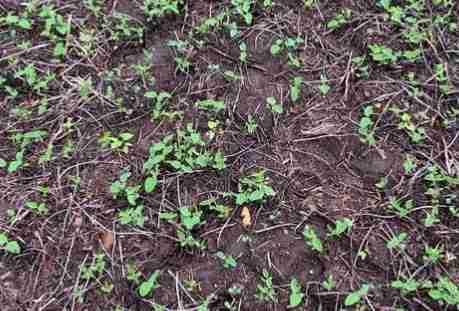By Michael Staton

Photo 1. Volunteer soybeans showing visible harvest losses in 2021.
Soybean producers are experiencing several harvest challenges this fall and many harvested fields have turned green due to volunteer soybeans (Photo 1). The most common problem is the high potential for shatter losses to occur due to the repeated wetting and drying cycles we’ve experienced across the state. These conditions weaken the suture on the pods making them brittle and prone to open prior to harvest or when struck by the reel. This situation is complicated even further as some fields or large areas within fields are badly lodged and in others, the stems are still green and tough.
The most important thing to remember when faced with brittle pods and green stems is don’t wait until the stems are dry to begin combining. If you wait for the stems to dry, the potential for large shatter losses to occur increases significantly.
The following recommendations should help you reduce shatter losses and plugging problems when harvesting soybean plants with green stems and/or brittle pods.
Develop a system for measuring gathering losses. I use a 1-foot square made from 1-inch PVC pipe. For the most common range of seed sizes, four beans per square foot on the ground equals one bushel per acre of lost yield. Drop the square multiple times across the header width and take the average.
If shatter losses are excessive, consider combining earlier in the morning or later into the evening when the pods have regained some moisture and are less brittle. However, this may increase plugging problems.
Reduce your ground speed to 3 mph or less if necessary. This will reduce shatter losses and plugging at the cutter bar by providing a crisp sideways cut.
Harvest at a 20-to-25-degree angle to the rows. This will improve cutter bar performance and provide more even feeding of the crop into the threshing cylinder or rotor. This may be the single most beneficial practice.
Draper heads should also reduce plugging problems when harvesting soybeans with green stems as they provide more uniform feeding into the threshing cylinder or rotor.
Air-assisted reels will reduce the loss of loose beans from the cutterbar when the nozzles on the drop tubes are properly positioned. The nozzles should be aimed so that the air blast contacts the head 2 to 5 inches behind the knife.
Consider removing rock dams if loose beans are building up on the cutterbar.
If the cutterbar is plugging, make sure that all knife sections and guards are sharp and tight. Check the hold down clips to make sure that they hold the knife within 1/32 of an inch. Adjust the wear plates so that they lightly touch the back of the knife. Check that the speed of the knife is correct, the drive mechanism hardware is fixed, tight and lubricated and the knife is in proper register with the guards.
According to Gary Huitink, former agricultural engineer with the University of Arkansas, improper reel speed and reel position cause more shatter losses than any other maladjustment. Maintaining the reel speed at 10 to 20% faster than the ground speed is a good starting point. Reduce the reel speed to the point that the reel just tips the plants toward the cutterbar and the reel appears to be pulling the combine into the plants. The height of the reel also affects shatter losses and should be adjusted so that it contacts the top one-third of the plants. Fore and aft reel position is important to reducing slug feeding. Generally, positioning the reel as close to the auger as possible promotes even feeding on combines equipped with auger heads.
Threshing problems result from worn parts on the cylinder or rotor and improper cylinder or rotor clearance or speed settings. The threshing equipment must be in good condition to handle soybeans with green/tough stems. Adjustments made to the cylinder/rotor clearance and speed is a balancing act between threshing losses and seed damage and split beans. Make one adjustment at a time and inspect the clean grain tank to determine your progress toward minimizing threshing losses and maximizing seed quality.
Lodged plants having brittle pods is a difficult combination to overcome as the common recommendations for gathering lodged plants will generally increase shatter losses. Under lodged conditions, increasing the reel speed in relation to ground speed, lowering the reel and moving the reel forwards improves the ability to cut and gather lodged plants. If the reel is shattering pods, decrease the reel speed to the point where the shattering stops. If the cutter bar rides over lodged plants after reducing the reel speed, decrease your ground speed. The most effective way to pick up lodged plants leaning in one direction is to harvest them with the plants leaning towards the combine. This means deadheading, which significantly reduces harvest efficiency. Harvesting at an angle to the lodged plants may be a workable alternative.
Soybean produces should apply the recommendations provided in this article, in your operator’s manual and by your local equipment dealer to reduce soybean harvest losses in 2021. Make one adjustment at a time and frequently stop to evaluate your progress in reducing gathering losses.
Source : msu.edu